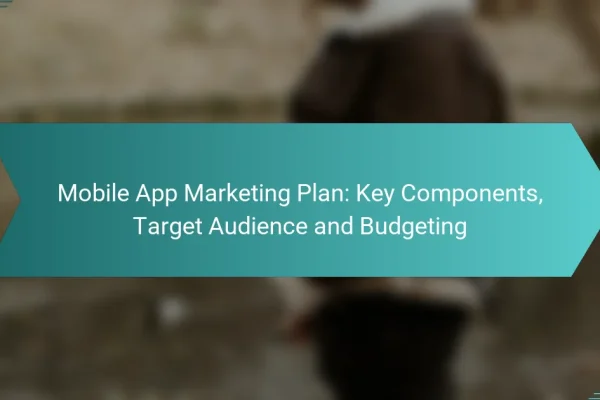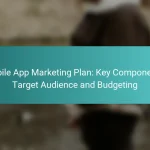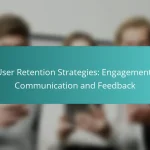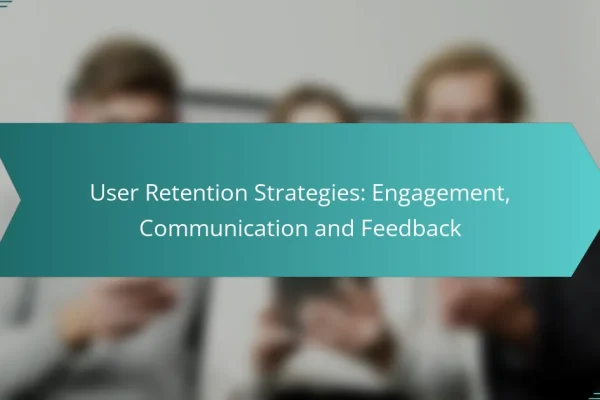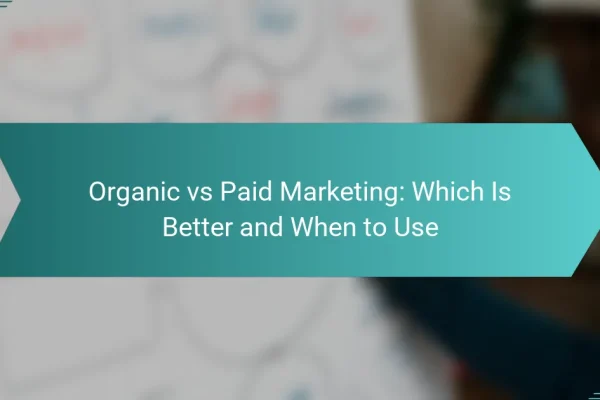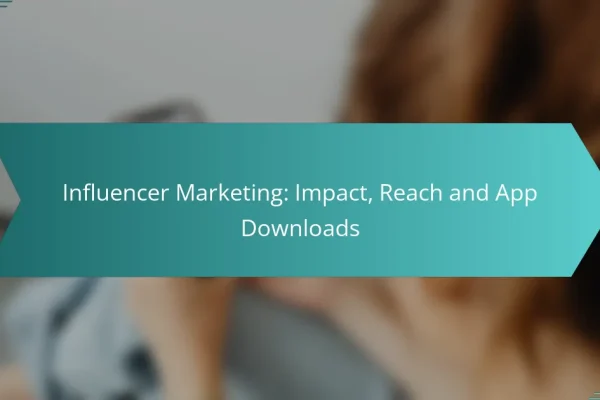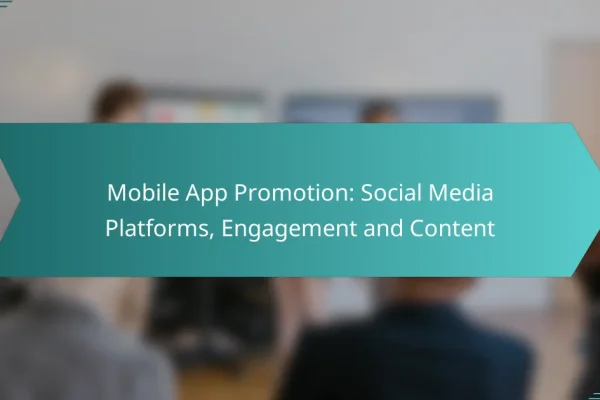What are effective app marketing strategies in Canada?
Effective app marketing strategies in Canada focus on leveraging digital channels to reach target audiences and drive downloads. Key methods include social media advertising, influencer partnerships, search engine optimization, email marketing campaigns, and content marketing.
Social media advertising
Social media advertising is a powerful tool for app marketing in Canada, allowing businesses to target specific demographics based on interests and behaviors. Platforms like Facebook, Instagram, and TikTok offer various ad formats, including stories and carousel ads, which can effectively showcase app features.
Consider allocating a budget for paid ads, starting with a few hundred Canadian dollars to test different creatives and audiences. Monitor performance metrics such as click-through rates and conversion rates to optimize your campaigns over time.
Influencer partnerships
Partnering with influencers can significantly enhance your app’s visibility in Canada. Influencers with a strong following in your app’s niche can create authentic content that resonates with their audience, driving downloads and engagement.
When selecting influencers, look for those whose values align with your brand and who have a genuine connection with their followers. Consider offering them exclusive access to your app or incentives for promoting it, such as affiliate commissions.
Search engine optimization
Search engine optimization (SEO) is crucial for improving your app’s visibility in app stores and search engines. Focus on optimizing your app’s title, description, and keywords to enhance discoverability.
Research relevant keywords that potential users might search for and incorporate them naturally into your app’s metadata. Regularly update your app’s content and encourage user reviews to boost its ranking in search results.
Email marketing campaigns
Email marketing campaigns can effectively engage users and encourage app downloads. Build an email list through your website or social media channels, offering incentives like exclusive content or discounts for sign-ups.
Craft targeted email campaigns that highlight your app’s features, updates, and user testimonials. Segment your audience based on their interests to deliver personalized content that drives higher engagement and conversion rates.
Content marketing
Content marketing involves creating valuable content that attracts and retains users while promoting your app. This can include blog posts, videos, and infographics that address topics relevant to your app’s audience.
Develop a content strategy that aligns with your app’s goals and audience needs. Share your content on social media and optimize it for search engines to increase visibility. Consider guest posting on popular blogs within your niche to reach a broader audience.
How to optimize app store listings?
Optimizing app store listings involves enhancing various elements to improve visibility and attract downloads. Key factors include effective keyword usage, engaging descriptions, and appealing visuals that resonate with potential users.
Keyword research
Keyword research is crucial for optimizing app store listings, as it helps identify the terms potential users are searching for. Utilize tools like Google Keyword Planner or App Annie to find relevant keywords with high search volumes and low competition.
Incorporate these keywords naturally into your app title, subtitle, and description. Aim for a balance between popular keywords and those that accurately reflect your app’s functionality to avoid misleading users.
Compelling app descriptions
Your app description should clearly convey its value and features within the first few lines, as this is what users see initially. Use concise language and bullet points to highlight key benefits, making it easy for users to grasp the app’s purpose quickly.
Consider including a call to action, encouraging users to download the app. Avoid jargon and focus on how your app solves a problem or enhances the user’s experience.
High-quality visuals
High-quality visuals, including app icons and screenshots, play a significant role in attracting users. Ensure your app icon is distinctive and visually appealing, as it is often the first impression users have of your app.
For screenshots, showcase the app’s main features and user interface. Use captions to explain what users can expect, and consider including a short video to provide a dynamic overview of the app’s functionality.
What are the best channels for app promotion?
The best channels for app promotion include paid search ads, social media platforms, and affiliate marketing. Each channel offers unique advantages and can help reach different segments of your target audience effectively.
Paid search ads
Paid search ads allow you to target specific keywords related to your app, placing your advertisement at the top of search engine results. This method is effective for capturing users actively searching for solutions your app provides.
Consider using platforms like Google Ads, where you can set a budget and bid for keywords. Monitor your return on investment (ROI) closely, as costs can vary widely based on competition and keyword popularity.
Social media platforms
Social media platforms such as Facebook, Instagram, and TikTok are powerful for app promotion due to their vast user bases and targeted advertising options. You can create engaging content that resonates with your audience, driving downloads through organic and paid strategies.
Utilize features like stories, reels, and sponsored posts to showcase your app’s features. Regularly analyze engagement metrics to refine your approach and maximize your advertising spend.
Affiliate marketing
Affiliate marketing involves partnering with individuals or companies who promote your app in exchange for a commission on each download or sale. This channel leverages the reach of affiliates to tap into new audiences without upfront costs.
Choose affiliates whose audiences align with your target market and provide them with clear guidelines and promotional materials. Track performance metrics to ensure that the partnerships are profitable and adjust your strategy as needed.
How to measure app marketing success?
Measuring app marketing success involves tracking various metrics that indicate how well your marketing strategies are performing. Key indicators include user acquisition, retention rates, and overall engagement, which help determine the effectiveness of your campaigns.
Key performance indicators
Key performance indicators (KPIs) are essential metrics that provide insight into your app’s marketing performance. Common KPIs include downloads, active users, session length, and user engagement rates. Monitoring these indicators helps you understand user behavior and the impact of your marketing efforts.
To effectively measure KPIs, set clear goals for each metric and regularly analyze the data. For instance, if your goal is to increase active users, track daily and monthly active users (DAU and MAU) to assess growth trends.
User acquisition cost
User acquisition cost (UAC) is the total expense incurred to acquire a new user, including marketing spend and promotional costs. Calculating UAC helps you evaluate the efficiency of your marketing strategies. A lower UAC indicates a more effective campaign, while a higher UAC may require adjustments to your approach.
To calculate UAC, divide your total marketing expenses by the number of new users acquired during a specific period. For example, if you spent $1,000 to acquire 100 users, your UAC would be $10. Aim to keep UAC within reasonable ranges based on your app’s monetization strategy.
Retention rates
Retention rates measure the percentage of users who continue to engage with your app over time. High retention rates indicate that users find value in your app, while low rates may signal issues with user experience or content. Tracking retention helps you identify areas for improvement and optimize user engagement.
To calculate retention rates, track the number of users who return to your app after a specific period, such as one week or one month. For example, if 100 users downloaded your app and 40 returned after one month, your retention rate would be 40%. Strive for retention rates that align with industry benchmarks, typically ranging from 20% to 40% for mobile apps.
What are common app marketing mistakes?
Common app marketing mistakes can significantly hinder an app’s success. These errors often stem from a lack of strategic planning and understanding of the target audience.
Poor targeting
Poor targeting occurs when marketing efforts do not reach the intended audience, leading to wasted resources. It’s crucial to define user personas based on demographics, interests, and behaviors to ensure your app appeals to the right users.
Utilizing tools like Google Analytics and social media insights can help identify the most relevant audience segments. Regularly revisiting and adjusting your targeting strategy based on performance data can enhance engagement and conversion rates.
Neglecting user feedback
Neglecting user feedback can result in missed opportunities for improvement and user retention. Actively seeking reviews and ratings on app stores, as well as conducting surveys, can provide valuable insights into user preferences and pain points.
Implementing a feedback loop where users see their suggestions being acted upon can foster loyalty. Regular updates that address user concerns can improve satisfaction and encourage positive word-of-mouth marketing.
Ignoring analytics
Ignoring analytics means missing critical insights into user behavior and app performance. Tracking metrics such as user acquisition costs, retention rates, and in-app engagement can inform marketing strategies and product development.
Utilizing analytics tools allows for real-time data analysis, enabling marketers to pivot strategies quickly. Regularly reviewing these metrics can help identify trends and make informed decisions to optimize marketing efforts and improve overall app success.
What are the latest trends in app marketing?
The latest trends in app marketing focus on leveraging data-driven insights, enhancing user experience through personalization, and utilizing emerging technologies like AI and AR. Marketers are increasingly prioritizing user engagement and retention strategies to stand out in a crowded marketplace.
Personalization strategies
Personalization strategies in app marketing involve tailoring content, recommendations, and experiences to individual user preferences and behaviors. This approach can significantly enhance user engagement and satisfaction, leading to higher retention rates.
To implement effective personalization, consider using data analytics to track user interactions and preferences. For example, sending personalized push notifications based on user activity can increase the likelihood of app usage. Additionally, segmenting your audience allows for targeted marketing campaigns that resonate more with specific user groups.
Common pitfalls include over-personalization, which can lead to privacy concerns, and failing to update personalization strategies based on changing user behaviors. Always ensure compliance with data protection regulations, such as GDPR in Europe, to maintain user trust.
